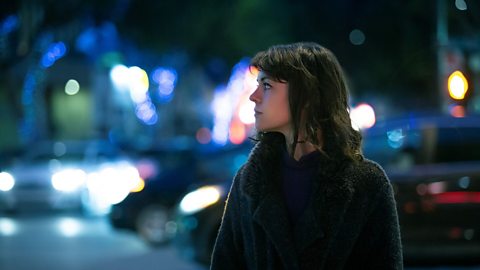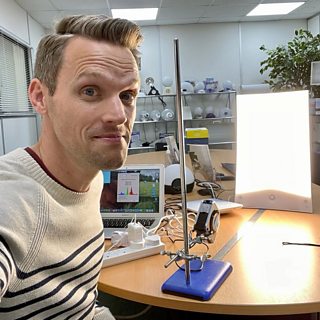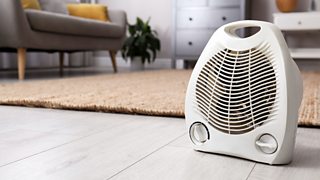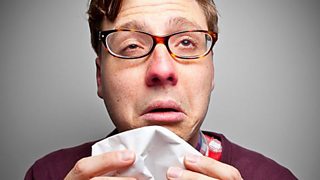Can SAD lamps and wake-up lights help boost your mood?
Sliced Bread is testing more of your suggested wonder products to see if their bold claims stand up to scrutiny.
Longer nights and overcast days can lead to the 'winter blues' for many and, for some, the more severe Seasonal Affective Disorder. There are claims that specially designed lights can help boost our mood in the darker months but listener Ross wants to know if SAD lamps really work? He asks what does the label 'medically certified' mean and is it worth paying extra for it?
In an aim to shed light on whether wake-up lights and light boxes really can improve how we feel, Greg Foot speaks to a leading expert in light therapy, and visits a manufacturer to find out if their claims really do stack up. Here's what he learned.
1. SAD is caused by a lack of exposure to light
"Many of us experience the 'winter blues', but Seasonal Affective Disorder is really overwhelming," says Russell Foster, Professor of Circadian Neuroscience and Head of the Department of Ophthalmology at Oxford University. Sufferers may feel overwhelmingly tired, lethargic and down over the winter period.
Sufferers may feel overwhelmingly tired, lethargic and down over the winter period.
"It's caused by changes in light intensity, which occur due to the long nights," says Russell. "Light is important for the regulation of our body clock: blue light receptors in the eye communicate with the master clock within the brain and this then aligns with billions of other clocks in the body which make up our 'circadian network'."
If the clocks in the body don't align with the light/dark cycle that our eyes are sensing, there's a disconnect – and we can begin to experience issues, says Russell.
2. Light therapy is not offered on the NHS
Dr Jon Van Niekerk from the Royal College of Psychiatrists advises that SAD should be treated in the same way as other types of depression: through talking therapies, like CBT, or medication, in accordance with guidance from the National Institute of Health and Care Excellence (NICE).
Light therapy is not normally available on the NHS, he says, so if you want to explore this avenue, you’re going to have to buy a device yourself. "The other issue is that actually you need to do a little bit of homework and see which ones have the most evidence around them," says Jon.
3. The amount of 'lux' a device emits is important
"We measure light intensity using lux," explains Russell. "A candle, at a metre away, is one lux. If we're by a window inside we might get 3,000 lux. In the middle of a room, that's dropped to a couple of hundred lux. On a bright sunny day, you can probably get up to 80, 90 or 100,000 lux, even in England."
Broadly speaking, to set the body clock, the more lux the better, he says. "Certainly, the light boxes, as they've been developing, have increased the amount of light that they give."

4. Wake-up lights are aimed at improving our circadian rhythms
Greg meets Dr Victoria Revell, scientific advisor to Lumie – a UK manufacturer of SAD lamps – and senior lecturer in Translational Sleep and Circadian Physiology at the Surrey Sleep Research Centre.
We鈥檙e trying to minimise... that groggy feeling when your alarm goes off.Dr Victoria Revell
They look at a wake-up light, which is designed to increase from an orange glow to a much brighter setting. "We're mainly concerned with improving people's circadian rhythms so that you get a better duration, a better quality of sleep, but also a better transition out of that," explains Victoria. "We’re trying to minimise what we call sleep inertia, so that groggy feeling when your alarm goes off and you’re jolted awake."
5. Slowly ramping up light in the morning has been shown to help with winter blues
Studies comparing slowly increasing light against instantly turning the lights on, showed that "ramping up was much more effective at aligning the body clock to the external world," says Russell. "So, if it can do that, and if we think SAD is a circadian problem, then yes, those wake-up lamps can be very effective."
However, lux remains key. Lumie’s wake-up light emits 2,500 lux at a distance of 20cm, but just 450 when it’s about a metre away. "I would like to see that a maximum output would be in the 1,000 to 2,000 lux range, because that’s the kind of strong stimulus that will set the clock," says Russell.
6. It's not just the amount of light, but how much blue light that's important
For our body clock, what's important is not just the amount of light, but how much blue light we're getting. "Melanopsin is the main photopigment that is responsible for driving the effects of light on your body clock," says Victoria. "This blue light content is measured using melanopic lux."
At a metre away Lumie's wake-up light measures 320 melanopic lux, and the recommendation for effectiveness on the body clock is anything over 250, says the scientist.

What is Seasonal Affective Disorder and what causes it?
Greg asks Professor of Circadian Neuroscience Russell Foster about the 'winter blues'.
7. SAD lamps offer more lux than wake-up lights
While wake-up lights are designed to gradually illuminate a space, SAD lamps are designed to be placed next to us. "You want to be bathing your face in light," says Victoria. They offer increased illumination. Lumie's most popular SAD lamp is the size of an A4 piece of paper. With the light sensor 50cm away, it gives out 3,800 lux.

The best light therapy is often, if it's available, to go outside.
8. Only some lights are branded 'medically certified'
Some lights are labelled 'medically certified' or 'medically approved'; others aren't.
"If it's a medical device, that means that we are recommending its use for a particular condition and that the evidence is there to support its use in that condition," states Victoria. The MHRA (Medicines and Healthcare products Regulatory Agency) and other approved bodies are responsible for checking each claim.
However, Russell says he is "somewhat uneasy" about the term because, for devices, this should entail rigorous experimental testing. In addition, although recognise that light therapy is a popular treatment they also state, "it is not clear whether it's effective."
9. Bright light in the morning can be more effective than Prozac
"There is a huge amount of evidence there that supports the use of light," argues Victoria. "The NHS guidelines themselves do say that light can have very positive effects."
A 2016 research paper looked at both seasonal and non-seasonal depression and compared 30 minutes of 10,000 lux in the morning with Prozac. "What was fascinating was that the light treatment was statistically more effective than Prozac and placebo at two weeks," says Russell, "and eight weeks is when Prozac became statistically significant from placebo, and light treatment was really much more effective than Prozac."
"So, we've got good evidence that bright light in the morning can reduce levels of depression, both in Seasonal Affective Disorder and in non-seasonal depression as well."
10. Sunlight remains the best source of lux
But although light has been proven to work, this doesn’t necessarily require a device.
"The best light therapy is often, if it's available to us, to go outside," says Russell, "because morning light outside is going to be very bright, even in the winter months. Sunlight, as in natural light, is the best thing. But if you can't get access to reasonably intense sunlight then use a light box."
Find out what other advice Greg had for listener Ross and whether he’s been convinced to switch on that SAD lamp by listening here.
The information contained in this article was correct at the time of broadcast on 17 November, 2022.

More articles from 成人快手 Radio 4
-
![]()
What's the best way to heat a room this winter?
Greg Foot gets cosy with different kinds of portable home heating options.
-
![]()
Can cooking with an air fryer save you money?
Seven things to consider before investing in an air fryer.
-
![]()
Boost your body and mind with nature
Dr. Michael Mosley explores the positive effects of spending time in nature.
-
![]()
How to stave off a cold
Greg Foot scrutinises the supposed benefits of hand sanitisers, vitamin C and zinc.





